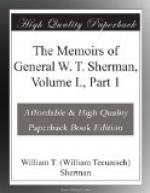When General Kearney first departed we took his office at Larkin’s; but shortly afterward we had a broad stairway constructed to lead from the outside to the upper front porch of the barracks. By cutting a large door through the adobe-wall, we made the upper room in the centre our office; and another side-room, connected with it by a door, was Colonel Mason’s private office.
I had a single clerk, a soldier named Baden; and William E. P. Hartnell, citizen, also had a table in the same room. He was the government interpreter, and had charge of the civil archives. After Halleck’s return from Mazatlan, he was, by Colonel Mason, made Secretary of State; and he then had charge of the civil archives, including the land-titles, of which Fremont first had possession, but which had reverted to us when he left the country.
I remember one day, in the spring of 1848, that two men, Americans, came into the office and inquired for the Governor. I asked their business, and one answered that they had just come down from Captain Sutter on special business, and they wanted to see Governor Mason in person. I took them in to the colonel, and left them together. After some time the colonel came to his door and called to me. I went in, and my attention was directed to a series of papers unfolded on his table, in which lay about half an ounce of placer gold. Mason said to me, “What is that?” I touched it and examined one or two of the larger pieces, and asked, “Is it gold?” Mason asked me if I had ever seen native gold. I answered that, in 1844, I was in Upper Georgia, and there saw some native gold, but it was much finer than this, and that it was in phials, or in transparent quills; but I said that, if this were gold, it could be easily tested, first, by its malleability, and next by acids. I took a piece in my teeth, and the metallic lustre was perfect. I then called to the clerk, Baden, to bring an axe and hatchet from the backyard. When these were brought, I took the largest piece and beat it out flat, and beyond doubt it was metal, and a pure metal. Still, we attached little importance to the fact, for gold was known to exist at San Fernando, at the south, and yet was not considered of much value. Colonel Mason then handed me a letter from Captain Sutter, addressed to him, stating that he (Sutter) was engaged in erecting a saw-mill at Coloma, about forty miles up the American Fork, above his fort at New Helvetia, for the general benefit of the settlers




